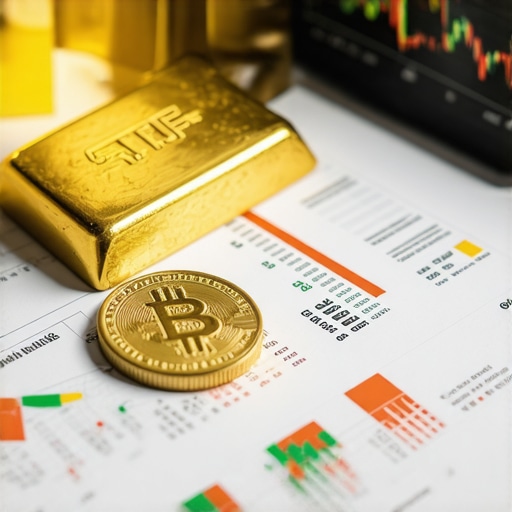Unearthing the Golden Path: Why Long-Term Gold Investments Matter
Gold has been a timeless symbol of wealth, a sanctuary during economic storms, and a strategic asset for portfolio diversification. But not all gold investments are created equal when it comes to securing long-term growth. In this article, we delve into the best types of gold investments that align with enduring financial goals, revealing nuanced approaches that seasoned investors leverage to maximize value over decades.
Shining Bright: Physical Gold Investments That Stand the Test of Time
Physical gold, including bullion bars and coins, remains a cornerstone for investors seeking tangible assets. Unlike paper-based instruments, owning physical gold offers direct control and a hedge against currency devaluation and inflation. Choosing between coins and bars involves considerations like liquidity, premium costs, and storage security. For instance, popular coins such as the American Gold Eagle or Canadian Maple Leaf combine collectability with recognized purity, making them excellent long-term holdings. Meanwhile, gold bars often provide lower premiums per ounce, appealing to investors aiming for bulk accumulation.
However, physical gold requires thoughtful storage solutions—safe deposit boxes or insured vaults—to mitigate risks of theft or loss. This direct ownership embodies the ancient wisdom of wealth preservation, enduring through centuries of market upheaval.
Digital Gold: How Gold ETFs and Mutual Funds Modernize Traditional Investment
For those who prefer liquidity and ease, gold Exchange-Traded Funds (ETFs) and mutual funds offer efficient pathways to gold exposure without handling physical metal. These instruments track gold prices closely and allow investors to buy and sell shares on stock exchanges seamlessly. ETFs like SPDR Gold Shares (GLD) or iShares Gold Trust (IAU) are popular choices for their low expense ratios and transparency.
Gold mutual funds, on the other hand, often invest not only in physical gold but also in gold mining companies, offering a blend of asset types with potential for dividend income. This diversification can enhance long-term growth but also introduces additional risks tied to company performance and operational factors.
Leveraging these financial vehicles can be a strategic move for investors balancing long-term growth with portfolio flexibility. For comprehensive insights, consider exploring types of gold investments including ETFs and stocks.
What Are the Risks and Rewards of Investing in Gold Mining Stocks for Long-Term Growth?
Gold mining stocks represent a dynamic segment of gold investments, offering leveraged exposure to gold prices through company operations. Their value often outpaces pure gold price movements during bullish markets due to operational leverage. However, they carry risks such as geopolitical factors, management effectiveness, and production costs.
Investors should assess financial health, mine lifespan, and geopolitical stability of mining regions. Historically, companies like Barrick Gold and Newmont have demonstrated resilience and growth potential, making them attractive for long-term portfolios. Yet, volatility is higher compared to physical gold or ETFs, requiring a well-informed and risk-tolerant approach.
Crafting a Balanced Gold Portfolio: Strategies for Sustainable Wealth Building
Combining physical gold, ETFs, mutual funds, and mining stocks creates a diversified gold portfolio that can harness multiple growth drivers while mitigating sector-specific risks. For example, pairing the stability of bullion with the growth potential of mining stocks and the liquidity of ETFs creates a resilient investment mosaic.
Seasoned investors often rebalance allocations based on macroeconomic indicators such as inflation trends, currency fluctuations, and geopolitical developments that influence gold demand. Staying attuned to these factors can enhance timing and selection of gold investment types for optimal long-term outcomes.
For a detailed strategy blueprint, see our guide on comprehensive gold investment strategies for the coming years.
Expert Insight: Navigating Gold Demand Trends and Market Dynamics
Understanding the supply-demand dynamics that drive gold prices is critical for long-term investors. Central bank gold purchases, jewelry demand in emerging markets, and shifts in industrial applications all influence price trajectories. For instance, increased central bank acquisitions have historically signaled tightening supply, pushing prices upward.
Moreover, evolving global economic uncertainties often enhance gold’s appeal as a safe haven. Staying informed through authoritative sources like the World Gold Council enables investors to anticipate market movements and adjust their portfolios proactively.
Explore more on this topic at What Drives Gold Demand: Trends Shaping the Market.
If you’re ready to deepen your gold investment knowledge and optimize your portfolio for the future, share your experiences or questions below. Engaging with a community of experts can provide invaluable perspectives on mastering gold investments for long-term growth.
Personal Reflections: Embracing the Emotional Side of Gold Investing
When I first ventured into gold investments, I underestimated the emotional rollercoaster that accompanied market fluctuations. Watching gold prices dip after a bullish run felt unsettling, even though I knew the long-term fundamentals remained strong. It taught me a valuable lesson: gold investing isn’t just about numbers; it’s about patience and trust in the asset’s enduring value. This emotional resilience is crucial, especially when navigating volatile periods or geopolitical uncertainties that often sway gold prices.
One strategy that helped me maintain composure was setting clear investment goals and avoiding reactionary decisions based on short-term market noise. This mindset shift aligns with insights from the World Gold Council, which emphasizes gold’s role as a long-term portfolio stabilizer rather than a get-rich-quick asset (World Gold Council Research).
Practical Tips: Safeguarding Your Physical Gold Investment
Owning physical gold brings a unique sense of security, but it also introduces practical challenges. Over the years, I’ve experimented with various storage options—from home safes to professional vaults. While keeping gold at home offers immediate access, it demands rigorous security measures to prevent theft or damage. Conversely, third-party vaults provide insured storage but require trust in the custodial institution.
For fellow investors considering physical gold, I recommend thorough research into storage providers and understanding insurance coverage terms. Additionally, documenting your holdings meticulously can streamline estate planning and ensure your assets remain protected for future generations.
How Can Investors Effectively Balance Gold Investment Types to Maximize Returns and Minimize Risks?
This question often comes up in discussions among gold enthusiasts and newcomers alike. From my experience, a well-diversified gold portfolio combines the stability of physical bullion with the liquidity of ETFs and the growth potential of mining stocks. Allocations might shift depending on market conditions, personal risk tolerance, and investment horizons.
It’s also beneficial to stay informed about macroeconomic trends and adjust your portfolio accordingly. For instance, during periods of rising inflation or geopolitical tension, increasing physical gold holdings can provide added security. Conversely, in stable economic environments, mining stocks or gold mutual funds may offer better growth opportunities.
If you’re interested in exploring strategies to build a balanced portfolio that suits your unique goals, check out this detailed guide on exploring gold mutual funds and portfolio building.
Staying Ahead: Leveraging Market Insights for Smarter Gold Investment Decisions
One of the most enlightening aspects of my gold investment journey has been learning to interpret market signals and demand trends. For example, tracking central bank gold purchases or shifts in jewelry demand can reveal underlying supply constraints that might influence prices.
Sources like the World Gold Council provide invaluable data that help decode these patterns. Their comprehensive reports not only highlight current trends but also forecast potential market shifts, empowering investors to make proactive decisions.
Engaging regularly with such resources has transformed my approach from reactive to strategic. I encourage you to explore these insights and integrate them into your investment planning.
Have you ever adjusted your gold investment based on emerging market trends or personal experiences? Share your story or questions below—let’s learn and grow together in this golden journey.
Mastering the Art of Timing: Leveraging Economic Cycles for Gold Investment Success
While gold is often prized as a long-term safe haven, the nuances of timing can significantly enhance investment outcomes. Recognizing where we stand within economic cycles—expansion, peak, contraction, or trough—enables investors to adjust gold exposure dynamically. For example, during inflationary expansions, physical gold and ETFs may outperform due to rising prices, whereas in contractions, gold mining stocks might offer more volatility but also opportunities for substantial gains if carefully selected.
Seasoned investors monitor leading economic indicators such as the Consumer Price Index (CPI), interest rate movements, and currency strength to anticipate shifts in gold demand and price. Incorporating these macroeconomic signals into portfolio adjustments can mitigate downside risks and capitalize on bullish momentum.
How Do Central Bank Policies Influence Long-Term Gold Investment Strategies?
Central banks play a pivotal role in shaping gold markets through their monetary policies and reserve management. When central banks increase gold reserves, it often signals concerns about currency stability or geopolitical risks, which can drive global gold prices upward. Conversely, selling gold reserves might reflect confidence in currency strength or liquidity needs, potentially dampening gold prices.
Investors aiming for long-term growth should closely analyze central bank behavior using data from authoritative sources like the World Gold Council’s Central Bank Gold Reserves Database. Understanding these trends helps anticipate supply-demand imbalances and informs allocation decisions across physical gold, ETFs, and mining equities.
Integrating Alternative Gold Assets: Exploring Gold-Backed Cryptocurrencies and Digital Innovations
The advent of blockchain technology has introduced innovative gold investment vehicles such as gold-backed cryptocurrencies and tokenized gold assets. These instruments promise the liquidity and transparency of digital assets combined with the intrinsic value of physical gold. For investors with a penchant for cutting-edge technologies, these alternatives offer diversification beyond traditional holdings.
However, these assets also carry unique risks—including regulatory uncertainties, counterparty reliability, and technological vulnerabilities—that require rigorous due diligence. Incorporating a modest allocation to these emerging gold-related digital assets can complement traditional investments but should be approached with caution and expert guidance.
Advanced Portfolio Construction: Quantitative Models and Risk Mitigation Techniques for Gold Investments
Expert investors increasingly employ quantitative models to optimize gold portfolio allocations, balancing expected returns against volatility and correlations with other asset classes. Techniques such as mean-variance optimization, Monte Carlo simulations, and scenario analysis allow for informed decisions on weighting physical gold, ETFs, mining stocks, and alternative assets.
Risk mitigation strategies include using options to hedge against price declines, setting stop-loss thresholds, and dynamically rebalancing portfolios in response to changing market conditions. Leveraging these sophisticated tools can enhance resilience and improve risk-adjusted returns over the long term.
For those interested in exploring these advanced methodologies, seminal research such as Markowitz’s Modern Portfolio Theory and recent applications in commodity investment provide valuable frameworks.
If you’re ready to deepen your understanding and refine your gold investment approach with cutting-edge strategies, consider engaging with expert forums and subscribing to specialized financial research platforms. Your journey toward mastering gold investment nuances continues here—share your questions or insights to join this evolving conversation.
Harnessing Behavioral Finance Insights to Enhance Gold Investment Decisions
Beyond quantitative metrics, incorporating behavioral finance principles can significantly refine gold investment outcomes. Cognitive biases such as loss aversion and herd behavior often drive suboptimal timing decisions, especially in volatile markets. Recognizing these psychological pitfalls enables investors to maintain discipline and adhere to long-term strategies despite short-term market noise.
Delving deeper, techniques like pre-commitment strategies and systematic investment plans in gold ETFs or mining stocks can mitigate emotional reactions. This approach aligns with findings from authoritative research, including the CFA Institute’s analysis on behavioral finance. Integrating these insights fosters resilience and consistency in portfolio growth.
Cryptographic Innovations and Regulatory Landscapes: Navigating Gold-Backed Digital Assets
As blockchain technology matures, gold-backed tokens and decentralized finance (DeFi) platforms are reshaping traditional investment paradigms. These digital assets offer fractional ownership, instantaneous settlement, and verifiable provenance, thereby democratizing access to gold investments globally. However, evolving regulatory frameworks necessitate vigilant compliance monitoring to mitigate systemic risks.
Investors should evaluate the underlying smart contract integrity, custodial arrangements of physical gold reserves, and jurisdictional legalities before allocation. Engaging with specialized platforms that publish audited reserve reports enhances transparency. This intersection of technology and regulation demands a sophisticated due diligence process distinct from conventional gold investing.
What Quantitative Techniques Can Optimize Gold Portfolio Allocation in Volatile Markets?
Advanced investors often employ techniques such as mean-variance optimization, conditional value at risk (CVaR) analysis, and Monte Carlo simulations to model portfolio performance under diverse economic scenarios. These methods allow for dynamic rebalancing that accounts for correlations between gold, equities, bonds, and alternative assets, optimizing risk-adjusted returns.
For instance, incorporating CVaR helps quantify tail risk exposure during market downturns, informing defensive allocation shifts toward physical gold or high-quality mining equities. Monte Carlo simulations provide probabilistic forecasts of portfolio trajectories, facilitating robust stress-testing against macroeconomic shocks.
Leveraging statistical software packages and programming languages like Python or R enables granular scenario analysis and real-time portfolio optimization, a practice increasingly adopted by institutional investors.
Strategic Engagement: Elevate Your Gold Investment Expertise
To truly master gold investment intricacies, continuous education and community interaction are paramount. Participating in expert webinars, subscribing to dedicated commodity research services, and engaging with thought leaders through professional networks can accelerate knowledge acquisition.
Consider exploring platforms like the World Gold Council’s Gold Hub Research, which provides cutting-edge analyses and data-driven insights tailored for sophisticated investors. Harnessing these resources empowers you to anticipate market shifts, optimize portfolio strategies, and navigate emerging asset classes with confidence.
Ready to deepen your strategic gold investment acumen? Share your perspectives or inquiries in the comments below and join a community dedicated to excellence in gold portfolio management.

Frequently Asked Questions (FAQ)
What are the primary advantages of investing in physical gold for the long term?
Physical gold provides direct ownership of a tangible asset, serving as a hedge against inflation, currency devaluation, and geopolitical risks. Its intrinsic value remains stable over centuries, offering portfolio diversification and security especially during economic turmoil. However, it requires secure storage and insurance to mitigate risks such as theft or loss.
How do gold ETFs differ from gold mutual funds in terms of long-term investment benefits?
Gold ETFs typically track the price of physical gold closely, offering high liquidity, low expense ratios, and ease of trading on stock exchanges. Gold mutual funds often include investments in gold mining companies alongside physical gold, which can provide dividend income and growth potential but also add company-specific risks. ETFs are generally more cost-efficient and transparent, while mutual funds offer diversified exposure within the gold sector.
What key risks should investors consider when including gold mining stocks in their portfolio?
Gold mining stocks are subject to operational risks such as production costs, geopolitical instability in mining regions, management efficiency, and fluctuating commodity prices. They can outperform physical gold during bullish cycles but also exhibit higher volatility. Evaluating company fundamentals, mine lifespans, and regional political environments is essential to mitigate these risks.
How can investors effectively balance different gold investment types to optimize returns and manage risks?
A diversified gold portfolio combining physical bullion, ETFs, mutual funds, and mining stocks can harness stability, liquidity, and growth potential. Allocations should be tailored to individual risk tolerance and economic outlooks, adjusting for inflation trends and geopolitical developments. Regular portfolio rebalancing informed by macroeconomic indicators enhances long-term resilience.
In what ways do central bank policies impact long-term gold investment strategies?
Central banks influence gold markets through their reserve management and monetary policies. Increased central bank gold purchases often signal concerns about currency risks, tightening supply and driving prices upward. Conversely, selling reserves can indicate confidence in currencies or liquidity needs, potentially suppressing prices. Monitoring central bank behavior helps investors anticipate market dynamics and adjust portfolio allocations accordingly.
Are gold-backed cryptocurrencies a viable option for long-term gold investment?
Gold-backed cryptocurrencies offer digital exposure to gold with benefits like fractional ownership, liquidity, and transparency via blockchain technology. However, they carry unique risks including regulatory uncertainty, counterparty reliability, and technological vulnerabilities. While they can complement traditional gold investments, cautious due diligence and modest allocation are advisable until regulatory frameworks stabilize.
What quantitative methods can be used to optimize gold portfolio allocation in volatile markets?
Techniques such as mean-variance optimization, Monte Carlo simulations, and conditional value at risk (CVaR) analysis enable investors to model portfolio risk-return trade-offs and stress-test against economic scenarios. These methods facilitate dynamic rebalancing and risk mitigation, incorporating correlations between gold and other asset classes to improve risk-adjusted returns.
How can behavioral finance insights improve gold investment decision-making?
Understanding cognitive biases like loss aversion and herd behavior helps investors avoid reactionary decisions during market fluctuations. Strategies such as pre-commitment, systematic investing, and disciplined adherence to long-term plans reduce emotional pitfalls. Integrating behavioral finance fosters greater resilience, ensuring consistency in gold portfolio growth.
What storage options ensure the safety of physical gold investments?
Safe deposit boxes, insured professional vaults, and high-security home safes are common storage solutions. Each has trade-offs between accessibility, cost, and security. Comprehensive insurance coverage and meticulous documentation are crucial to protect against theft, damage, and to facilitate estate planning.
How can economic cycles be leveraged to enhance gold investment timing?
Analyzing phases of economic expansion, peak, contraction, and trough enables investors to adjust gold exposure strategically. Inflationary periods favor physical gold and ETFs, while contractions may present opportunities in mining stocks. Monitoring indicators such as CPI, interest rates, and currency strength informs tactical allocation to maximize returns.
Trusted External Sources
- World Gold Council (WGC): The authoritative body on gold market data, trends, and research. WGC offers comprehensive insights into gold demand, supply, central bank policies, and investment strategies, making it indispensable for informed investors.
- CFA Institute: Provides advanced research on behavioral finance and investment decision-making frameworks, enabling investors to incorporate psychological insights into portfolio management.
- Markowitz’s Modern Portfolio Theory Research: Seminal academic work foundational to quantitative portfolio optimization, guiding sophisticated asset allocation approaches including gold investments.
- SEC Filings of Leading Gold Mining Companies (e.g., Barrick Gold, Newmont): Offer detailed financial and operational data essential for evaluating mining stock risks and growth potential.
- Financial Data Platforms like Bloomberg and Reuters: Deliver real-time market data, economic indicators, and analytical tools crucial for monitoring gold price drivers and economic cycles.
Conclusion
Long-term gold investments require a nuanced balance of asset types, strategic timing, and awareness of market dynamics. Physical gold offers enduring security and inflation protection, while ETFs and mutual funds provide liquidity and diversified exposure. Gold mining stocks introduce growth potential tempered by operational risks. Integrating behavioral finance insights and quantitative optimization techniques further refines investment decisions, fostering resilience amidst volatility.
Central bank policies and economic cycles remain key navigational beacons, influencing gold demand and price trajectories. Emerging innovations like gold-backed cryptocurrencies add complexity and opportunity, demanding cautious exploration.
By synthesizing these expert insights, investors can craft robust gold portfolios aligned with long-term wealth preservation and growth objectives. Engage with trusted research sources, remain disciplined against emotional biases, and continuously refine your strategy to harness gold’s full potential.
Ready to elevate your gold investment expertise? Share your experiences or questions below, explore our related expert content, and embark confidently on your golden journey toward sustainable financial growth.
#IMAGE_PLACEHOLDER_D#











I appreciated how this article separates the different ways to own gold — that distinction made a real difference in my approach. I started with physical coins (American Gold Eagles) because of the psychological comfort and as a hedge during currency swings, but I gradually shifted a portion into ETFs (GLD and IAU) for liquidity after needing cash quickly during 2020 volatility. That experience taught me to keep a small, liquid ETF position alongside longer‑term bullion stored in an insured vault rather than at home.
I also experimented with a modest allocation to mining stocks (Newmont, Barrick) for growth potential, but only after checking mine lifespans and recent SEC filings. Behavioral tools helped me stay disciplined: a monthly DCA into ETFs and a pre-commitment to not sell physical gold unless an emergency hits.
I’m curious — for people who hold both coins/bars and ETFs, how do you document and integrate physical holdings into estate plans? Any trusted vault providers or documentation tips others have found indispensable?